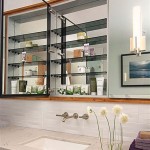Are Rear View Mirrors in Cars Concave or Convex?
The side and rearview mirrors found in vehicles play a crucial role in driver safety and situational awareness. Understanding the type of mirror used and its optical properties is essential for proper usage and interpretation of the reflected images. While the interior rearview mirror is typically a plane (flat) mirror, the exterior side-view mirrors commonly utilize convex mirrors.
A plane mirror reflects light rays in such a way that the image appears the same size as the object and at the same distance behind the mirror as the object is in front of it. This provides a true representation of the scene behind the vehicle, but with a limited field of view. Hence, its application in the interior rearview mirror, providing a direct view of the rear window.
Convex mirrors, on the other hand, curve outwards. This curvature causes light rays to diverge upon reflection, resulting in a smaller, virtual image. While the diminished image size might seem like a disadvantage, it significantly increases the field of view, allowing the driver to see a wider area behind and to the side of the vehicle. This wider perspective is invaluable for lane changes, merging, and parking maneuvers.
The trade-off for this expanded field of view is the altered perception of distance. Objects in a convex mirror appear farther away than they actually are. This phenomenon is due to the smaller image size, which the brain interprets as increased distance. The phrase "objects in mirror are closer than they appear," often printed on passenger-side mirrors, serves as a crucial reminder of this optical effect and cautions drivers to account for the distorted depth perception.
The choice between a plane and a convex mirror depends on the specific application and the desired balance between image size and field of view. For the interior rearview mirror, the accurate representation of distance provided by a plane mirror is prioritized, allowing the driver to judge the speed and distance of trailing vehicles effectively. However, for side-view mirrors, the expanded field of view offered by a convex mirror is deemed more critical for overall safety and awareness, despite the distortion of distance.
The curvature of a convex mirror dictates the degree of magnification and field of view. A more strongly curved mirror provides a wider field of view but also further diminishes the size of the reflected objects and increases the perceived distance. Automotive engineers carefully select the curvature of side-view mirrors to optimize the balance between these factors, maximizing the usable visual information provided to the driver.
Regulations and standards regarding the specifications of automotive mirrors exist in many jurisdictions. These regulations often specify the minimum field of view required for side-view mirrors, ensuring drivers have adequate visibility of the areas beside and behind their vehicles. They may also dictate the placement and size of mirrors to ensure optimal driver ergonomics and minimize blind spots.
The use of convex mirrors in side-view mirrors is a deliberate design choice based on the principles of optics and a prioritization of safety. While the resulting image distortion requires drivers to adjust their perception of distance, the significantly increased field of view contributes significantly to reducing accidents and enhancing overall driving safety.
Technological advancements continue to influence the development of automotive mirrors. Blind spot monitoring systems, lane departure warnings, and rearview cameras are increasingly integrated into modern vehicles, supplementing the information provided by traditional mirrors. These systems utilize sensors and cameras to detect objects that might not be visible in the mirrors, further enhancing driver awareness and safety.
Understanding the properties of convex mirrors and their application in side-view mirrors is crucial for all drivers. Recognizing the inherent distortion of distance and compensating for this effect is essential for safe driving practices. By utilizing the expanded field of view effectively and interpreting the reflected images accurately, drivers can significantly enhance their situational awareness and mitigate potential hazards on the road.
In summary, while the interior rearview mirror typically uses a plane mirror for an undistorted view, the exterior side-view mirrors utilize convex mirrors to provide a wider field of vision, despite the resulting image size reduction and distance distortion. This design prioritizes the wider perspective for enhanced safety and situational awareness, reminding drivers to account for the optical effects of convex mirrors while driving.
The continued development and integration of advanced driver-assistance systems (ADAS) are further enhancing driver perception and safety, working in conjunction with traditional mirror systems to provide a more comprehensive understanding of the vehicle's surroundings.

Convex And Concave Mirrors In Cars

Concave Vs Convex Mirrors In Cars
In Trucks Cars Buses Side View Mirrors Are Convex But Center Rear Mirror Is Or Plane Quora

Convex Mirrors Use Car

Types Of Mirror For Vehicles Concave Vs Convex Sunway Autoparts

Types Of Mirror For Vehicles Concave Vs Convex Sunway Autoparts
Why Don T Car Manufacturers Use Convex Mirrors As A Rear View Mirror This Could Enable You To See Cars On Each Side Of Quora

Why Do We Prefer A Convex Mirror As Rear View In Vehicles

Which Mirror Is Used For Rear View Image And Why Describe With Ray Diagram Edurev Class 10 Question

Types Of Mirror For Vehicles Concave Vs Convex Sunway Autoparts








